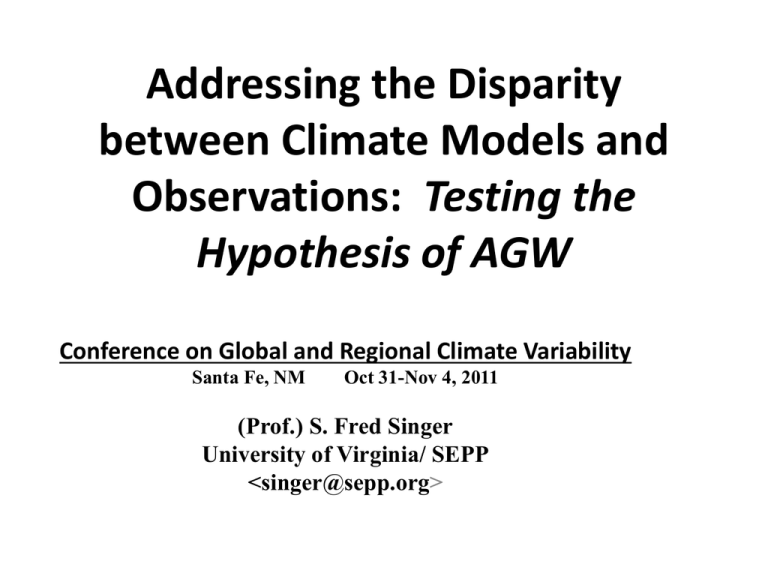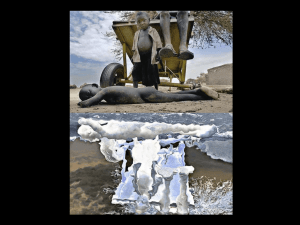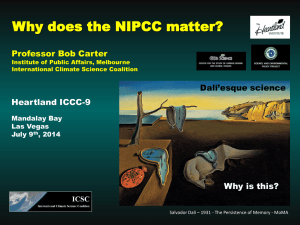Addressing the Disparity between Climate Models and Observations
advertisement

Addressing the Disparity between Climate Models and Observations: Testing the Hypothesis of AGW Conference on Global and Regional Climate Variability Santa Fe, NM Oct 31-Nov 4, 2011 (Prof.) S. Fred Singer University of Virginia/ SEPP <singer@sepp.org> Summary • The reports of the IPCC [2007], of the USClimate Change Science Program [CCSP-SAP1.1 2006], and of the NIPCC [2008] all show a major disparity between modeled and observed patterns of temperature trends. In particular, all GH models show a “hot spot” in the tropical upper troposphere; however, radiosonde and independent satellite observations do not. • Resolving the conflicting claims • Based on recent papers by Singer [Energy&Envir 2011], by Fu et al [GRL 2011], and by Thorne et al [JGR 2011], we try to resolve the current controversy between Douglass et al [DCPS in IJC 2007] and Santer et al [IJC 2008]. DCPS and Santer report conflicting results when comparing observed and modeled patterns of temperature trends ("fingerprints"). For example, DCPS report a disparity, while Santer claims “consistency” -- that observed temperature trends in the tropical troposphere agree with trends derived from GeneralCirculation Models (GCMs). Santer’s claim is based mainly on the visual overlap above 400 hPa, seen in his Fig. 6, between a new set of tropospheric temperature trends (RAOBCORE, derived from Reanalysis) and the interval of uncertainty in the modeled trend values, derived from the "20CEN" set of GCMs compiled by the Intergovernmental Panel on Climate Change (IPCC 2007). Findings • Like Fu, we find that the "new set of tropospheric temperature trends" is not in accord with satellite data – contra Santer’s claim. Further, the "error interval" deduced for the model trends (the grey area of Santer’s Fig. 6) may simply be an artifact caused by the presence of many single-run models in the IPCC’s “20CEN” compilation. If "chaotic uncertainty" of models were eliminated, this grey envelope would shrink -- and any overlap between the modeled error interval and observed temperature trends would be less likely. Thorne et al, which includes Santer as a coauthor, conclude that “… agreement between models, theory, and observations … is nonexistent above 300 hPa.” • Thus, observations and models remain inconsistent -raising questions about IPCC's estimates of "climate sensitivity" and hence the magnitude of anthropogenic global warming imagined by the GCMs. Three Fundamental Issues • 1. Is climate change of the 20th century anthropogenic (human-caused)? • 2. If AGW is significant, is a future warmer climate (and higher CO2 level) good or bad ? • 3. If a future warming is calamitous, can we really do something about it? Can we lower atmospheric CO2 levels, phase out fossil fuels, make solar and wind power reliable and cheap, produce biofuels economically? Three Major Science Questions “Gallia est omnis divisa in partes tres” • 1. Natural or Anthropogenic Forcing? A Science and also a Policy Issue • 2. Why the Disparity between Models & Obs? Negative feedback or Saturation? • 3. What is Causing Climate Variability? Internal oscillations or External factors? Is There Disparity between Modeled and Observed Temperature Trends? • Attribution of observed warming trends to GH-gas increases is based largely on claimed agreement between the patterns of observed (tropical) tropospheric trends and modeled ones [Santer et al., in IPCC 1996, Chap 8, and in IJC 2008, Fig 6]. We show that the claimed consistency is spurious. • The “fingerprints” don’t match. SOURCES • 1. IPCC-4 (2007) and CCSP-SAP-1-1 (2006) www.climatescience.gov/library/sap/sap11/finalreport/default.htm • 2. NIPCC Summary (2008) http://www.sepp.org/publications/NIPCC_final.pdf • 3. Singer (E&E 2011) “Lack of consistency …” and references therein http://multiscience.metapress.com/content/kv75274882804k98 /fulltext.pdf From Energy & Environment , vol 22, no 4, pp 375-406, 2011 LACK OF CONSISTENCY BETWEEN MODELED AND OBSERVED TEMPERATURE TRENDS S Fred Singer University of Virginia/ SEPP Email: singer@sepp.org ABSTRACT The US Climate Change Science Program [CCSP, 2006] reported, and Douglass et al. [2007] and NIPCC [2008] confirmed, a “potentially serious inconsistency” between modeled and observed trends in tropical surface and tropospheric temperatures. However, Santer et al. [2008: hereafter “Santer”], though sharing several co-authors with CCSP [2006], offered “new observational estimates of [tropical] surface and tropospheric temperature trends”, concluding that “there is no longer a serious discrepancy between modelled and observed trends.” Santer’s key graph [shown here as Fig. 5] misleadingly suggests an overlap between observations and modeled trends. His “new observational estimates” conflict with satellite data. His modeled trends are an artifact, merely reflecting chaotic and structural model uncertainties that had been overlooked. Thus the conclusion of “consistency” is not supportable and accordingly does not validate model-derived projections of dangerous anthropogenic global warming (AGW) CCSP 1.1 – Chapter 1, Figure 1.3F PCM Simulations of Zonal-Mean Atmospheric Temperature Change Height (km) CCSP 1.1 – Chapter 5, Figure 7E Height (km) A more detailed view of the disparity: Douglass, Knox, Pearson, Singer IJC 2007 Reaction to DCPS (IJC 2007) • Santer et al (IJC 2008) claim “Consistency” of modeled and observed trends – by: • 1. Adding a new dataset that has a max trend in the upper troposphere, at 200 hPa • 2. Greatly expanding the uncertainty interval of the modeled trends But others confirm DCPS(IJC 2007) and Singer (Energy&Envir 2011) • Fu, Manabe, Johanson (GRL 2011): It is "critically important to understand the causes responsible for the discrepancy between the models and observations.” “… trends from [satellites] are significantly smaller than those from GCMs” • Thorne, Santer, et al (JGR 2011): " ... agreement between models, theory, and observations .. is nonexistent above 300 hPa." Two different views from CCSP • A. In Chap 5 (Santer, lead author) shows a clear disparity between model runs and data. • B. But the Exec Summary (Wigley, lead author) suggests overlap (i.e., Consistency), by using the concept of ‘range’ (i.e., Max--Min of the distribution) – not a valid statistical metric. (a) CCSP 1.1 – Chapter 5, Figure 4G (b) CCSP 1.1 - Executive Summary Figure 4G: Modeled and Observed Temperature Trends in the Tropics (20oS-20oN) a. b. Model uncertainty (‘grey area’) • Santer et al (2008) claim that the ‘grey area’ (in Panel A) denotes 2-sigma uncertainty. Singer 2011 finds that it is the ‘range’ (Max—Min) of the model runs –an impermissible statistical metric – thereby greatly inflating the model uncertainty. • Santer claims (in Panel B) that the new dataset is supported by satellite data. But Singer (E&E 2011) and Fu, Manabe, Johanson (GRL 2011) both disagree with Santer. hPa Trend (K/dec) (K/dec) K/dec -0.2 150 200 hPa 300 500 850 0 0.2 0.4 0.6 1 sims9 2 sims5 3 sims5 4 sims5 5 sims5 6 sims4 7 sims4 8 sims3 9 sims3 10 sims3 11 sims3 12 sims3 13 sims2 14 sims2 15 sims2 16 sims2 17 sims2 18 sims1 19 sims1 20 sims1 21 sims1 22 sims1 Santer trend Grey left Grey right Climate models are chaotic • E.g., the 5 runs of the Japan MRI model show trends ranging from 0.042 to 0.371 K/decade. • Which of these 5 modeled trends should we compare to the observed trend? • In a synthetic experiment we show that at least 40 runs (of 20-yr length) are necessary to get convergence of the ‘cumulative ensemblemean – and >20 runs of 40-yr long runs. Cumulative Ensemble-mean trend vs. Number of runs CONCLUSION-1 • Modeled fingerprints don’t match observed • Models are not validated; should not be used as policy tools • Individual model runs show wide variations of temp trends – evidence of chaotic behavior • We need more studies to explain what causes discrepancy between models and obs • THANK YOU FOR YOUR ATTENTION CONCLUSION-2 • 1. The US-CCSP report shows major differences between observed temp trends and those from GH models • These disagreements are confirmed and extended by Douglass et al [in IJC 2007] and by NIPCC 2008 • Claims of “consistency’” between models and obs by Santer et al [in IJC 2008] are shown to be spurious • 2. IPCC-4 [2007] climate models use an insufficient number of runs to overcome “chaotic uncertainty” • 3. We find no evidence in support of the surface warming trend claimed by IPCC-4 as evidence for AGW • We conclude that current warming is mostly natural and that the human contribution is minor.








